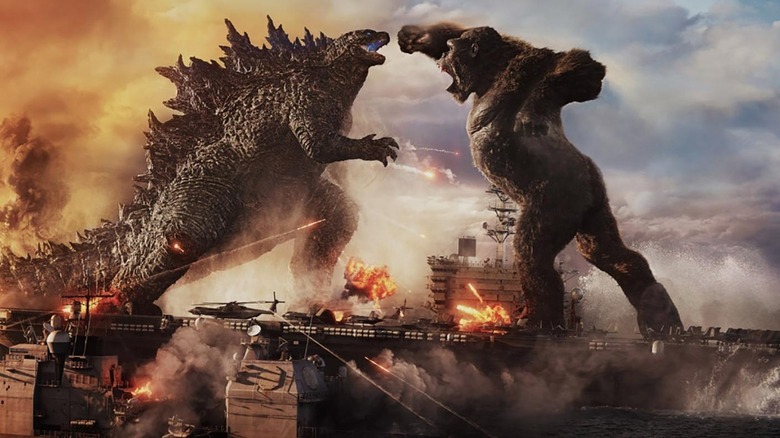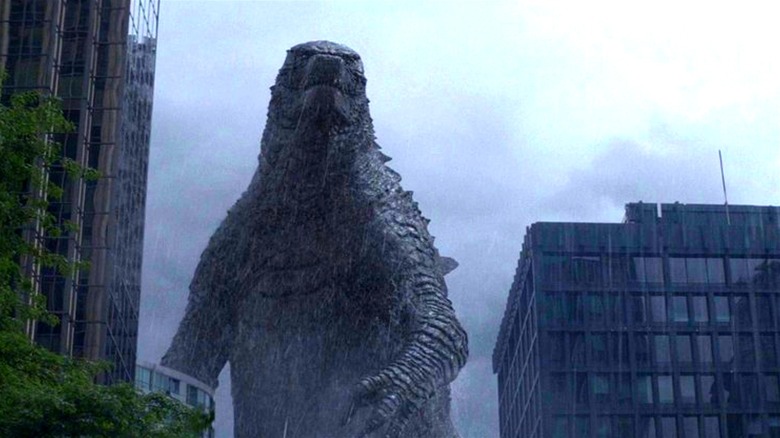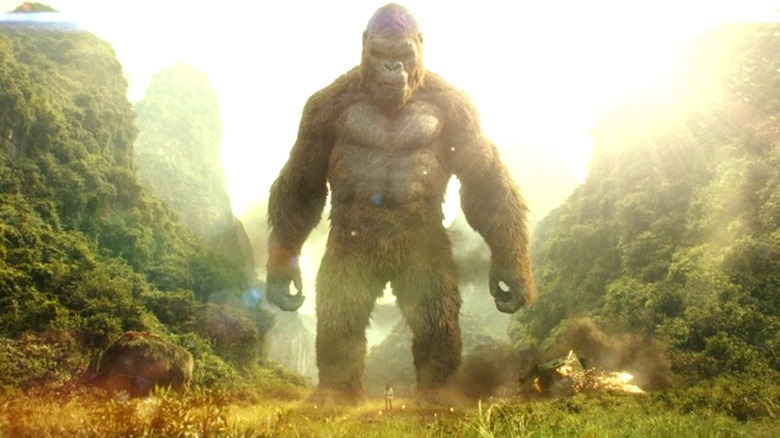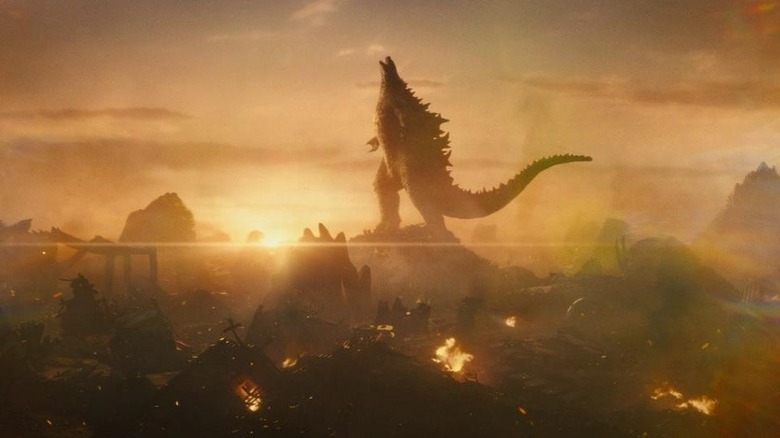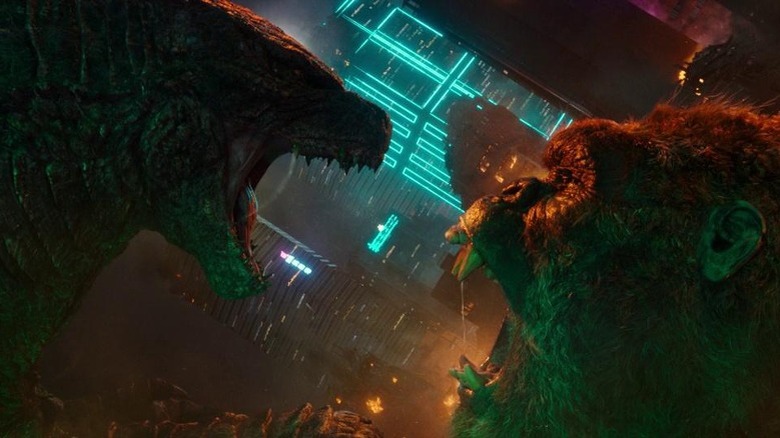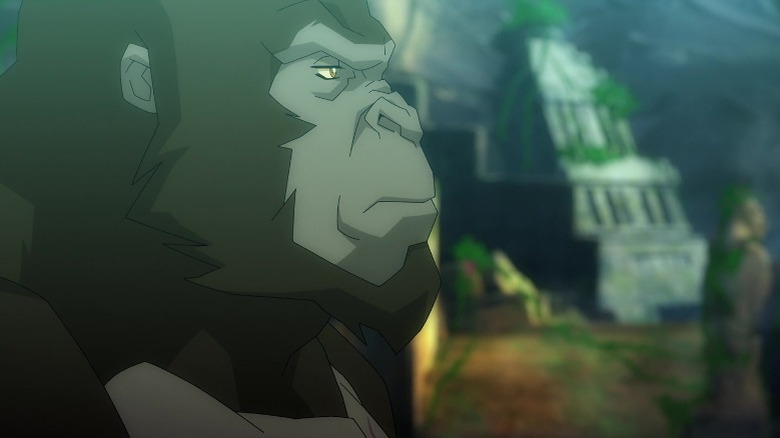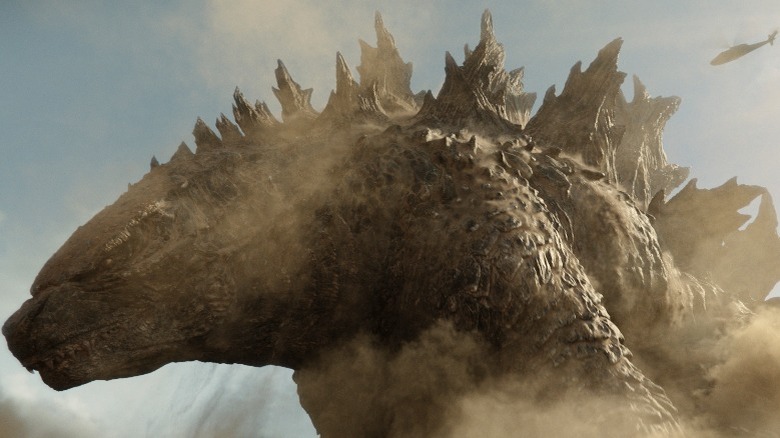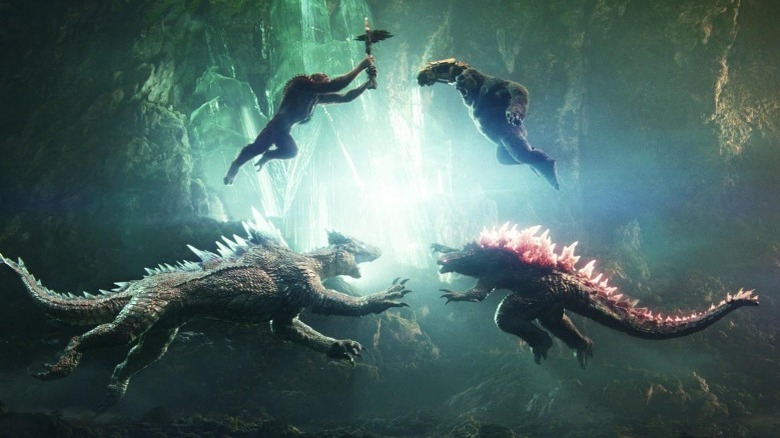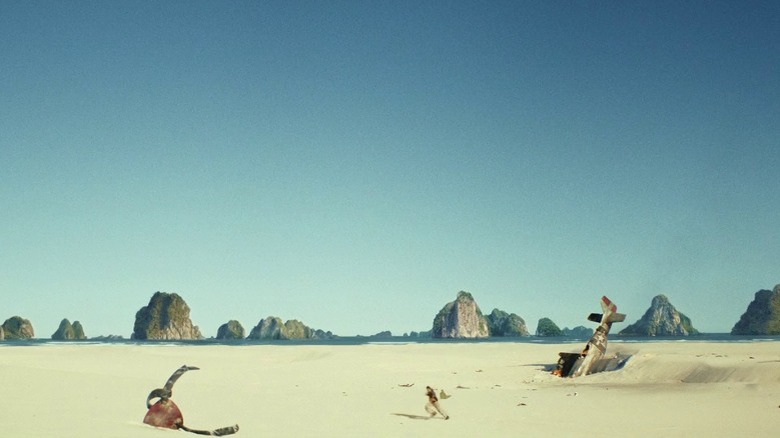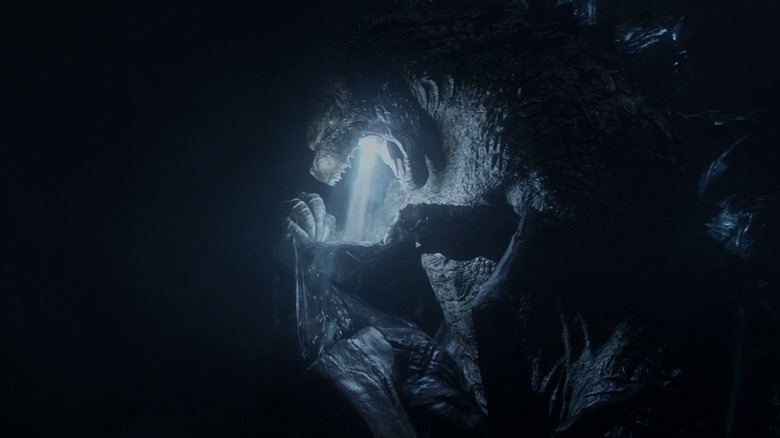The Best Way To Watch The MonsterVerse Movies In Order
In 2024, "Godzilla x Kong: The New Empire" blew everyone away at the box office, becoming the most successful entry in what has turned out to be a much more profitable and enjoyable cinematic universe than many expected: the MonsterVerse. Reviving and Americanizing the Japanese tradition of kaiju films was a smart move. Producers saw fertile ground for hyped-up crossovers between different giant monsters, and the MonsterVerse has been making bank for a decade now by betting on audiences' eagerness to see kaiju alternately fight each other and team up against common threats.
The MonsterVerse brings back decades-old pieces of lore from both the "Godzilla" and "King Kong" franchises, including several other monsters in addition to the giant lizard and the big ape, and folds them all into an epic sci-fi continuity. If you're looking to take a plunge of your own into the Hollow Earth and watch all of the MonsterVerse movies, either for the first time or as a repeat viewer, there are several different ways you can do so. In this article, we're going to run through every entry in the MonsterVerse franchise in order of release, and then present two alternate viewing orders for you to consider.
Godzilla
The MonsterVerse kicked off in 2014 with the release of "Godzilla," a Legendary/Warner Bros. production that served as a Hollywood reboot of the long-running "Godzilla" franchise. A few things were notable about this release: For starters, it was the 30th "Godzilla" film overall, following several decades and various different eras for the franchise in its native Japan. It was also the second American "Godzilla" film, following the 1998 Roland Emmerich movie from TriStar Pictures, which made money but is arguably one of the worst "Godzilla" movies ever made. Thirdly, given that the "Godzilla" series had yet to be rebooted again in Japan and enter its fourth era (which would not happen until 2016's "Shin Godzilla"), 2014's "Godzilla" was also the first Godzilla film from any country in a decade.
Legendary's bet on a brand new, star-studded Hollywood kaiju blockbuster paid off handsomely. Gareth Edwards' "Godzilla" begins its story, funnily enough, back in 1999, with the unexplained destruction of a nuclear power plant in Japan. Jumping forward to 2014, the film follows the tradition of Toho classics like "Ghidorah, the Three-Headed Monster" and depicts Godzilla as an uneasy ally to humanity against a common threat — in this case, the two winged creatures that introduce the MonsterVerse-specific concept of Massive Unidentified Terrestrial Organisms (MUTOs). Generally well-received by critics, "Godzilla" became a worldwide box office hit with a $525 million gross, laying the groundwork for a whole monster-based American franchise.
Kong: Skull Island
The "King Kong" franchise could be called the American parallel to the "Godzilla" franchise. Beginning in 1933 with Merian C. Cooper and Ernest B. Schoedsack's seminal classic "King Kong," it's a similarly long-running film series veering between adventure and horror that also peppered the back half of the 20th century with periodic releases — albeit significantly fewer than "Godzilla." Following two back-to-back films in 1933, the "King Kong" franchise lay dormant for decades before being resurrected in the 1960s on the back of revived public interest in monster films due to the success of "Godzilla." Several more films followed, leading up to the celebrated 2005 Peter Jackson-directed remake of the 1933 original.
Then, in 2017, the "King Kong" series was once again brought back as a result of a certain Japanese reptilian monster breaking the door open. Fresh off the smashing success of its "Godzilla" reboot, Legendary Pictures dipped its feet into the "King Kong" well with "Kong: Skull Island," directed by Jordan Vogt-Roberts. Written as an express building block to an eventual crossover franchise with "Godzilla," "Kong: Skull Island" is not a straight reboot, but rather a retelling of the "Kong" mythos through another lens and featuring a different set of human characters. The film takes place in 1973 following a brief 1944 prologue, and, this time around, instead of filmmakers, Skull Island is visited by scientists and Vietnam War veterans. The franchise's second entry beat the first at the global box office, raking in $568 million worldwide.
Godzilla: King of the Monsters
Not all contemporary viewers are aware of this, but, back in the day, large swaths of the American public were introduced to Godzilla not through the original 1954 "Godzilla," but through a heavily re-edited American cut of the film featuring new footage directed by Terry O. Morse. That version was released in 1956 and titled "Godzilla, King of the Monsters!" So there may have been a bit of meta-humor to the decision to bring back that title for Legendary's 2019 sequel to "Godzilla."
Effectively the "Iron Man 2" of the MonsterVerse — as in, a sequel to the film that started the cinematic universe in question, coming just before the crossing-over started happening with full force — "Godzilla: King of the Monsters" was helmed and co-written by Michael Dougherty. Sticking with superhero franchise comparisons, this film could also be called the American "Godzilla" reboot's equivalent to the DCEU's "Justice League," in that it served to hastily introduce a whole set of iconic characters into the franchise: King Ghidorah as the new arch-villain, Rodan as his sidekick, Mothra as Godzilla's ally in the fight against them. The human ensemble, meanwhile, was entirely new, save for Sally Hawkins, David Strathairn, and Ken Watanabe reprising their roles.
While "King of the Monsters" is far from a masterpiece, it's a real treat for kaiju lovers, with plenty of memorable set pieces. It didn't do as well as the previous two MonsterVerse films at the box office (it managed to pull in $387 million globally), but it nonetheless fulfilled its duty to further expand the franchise and set things up for the crossover event that would finally happen two years later.
Godzilla vs. Kong
The concept of a film bringing Godzilla and King Kong together isn't a new one by any stretch. As a matter of fact, when the "Godzilla" franchise first took off in the mid-20th century and breathed new life into the monster movie subgenre, sparking the public interest that would allow King Kong to return to silver screens for the first time since 1933, the ape king's comeback happened not in Hollywood, but in Japan — through a Godzilla crossover. Produced by Toho and directed by Ishirō Honda, 1962's "King Kong vs. Godzilla" set the precedent for the film that would officialize the unity of Legendary's MonsterVerse nearly six decades later: 2021's "Godzilla vs. Kong."
The first Hollywood film to pit the two famous monsters against one another, the Adam Wingard-directed "Godzilla vs. Kong" follows a (perhaps too convoluted) plot about an Apex Cybernetics team using Kong as a guide into the Hollow Earth, where the interests of monsters, corporations, and humanity itself clash in various ways. Along the way, Godzilla and Kong form a rivalry that unfolds via several battles, with the climatic one occurring in Hong Kong. But their rivalry turns out to be just a prelude to the real threat posed by Mechagodzilla, which finally gets its introduction into the MonsterVerse. Its role in the story eschews the heroism of its previous appearances in the "Godzilla" franchise and harkens back to its more villainous original function in 1974's "Godzilla vs. Mechagodzilla."
Skull Island
Following the quadruple punch of "Godzilla," "Kong: Skull Island," "Godzilla: King of the Monsters," and "Godzilla vs. Kong," the MonsterVerse was established enough as a media franchise to branch off into different forms of storytelling. Thus, in June 2023, two years after "Godzilla vs. Kong," the newest MonsterVerse installment came not in the form of another theatrical feature film, but as the first season of a Netflix animated series.
Developed by Brian Duffield, who wrote all eight of the first season's episodes, "Skull Island" delivers more-or-less what you'd expect from that straight-to-the-point title: An expedition to Skull Island. This journey is undertaken by characters far removed from most of the previously-depicted MonsterVerse action. Taking place in the 1990s, the series follows a group of sea explorers and cryptid hunters who come across a girl (Mae Whitman) adrift in the ocean, rescue her, and then find themselves separated and stranded on Skull Island after their ship gets attacked by a kraken.
On Skull Island, new franchise mythology gradually begins to emerge, with the explorers learning more about the girl, the mysterious scientist (Betty Gilpin) who's leading a band of mercenaries on a hunt for her, and the vast history of Skull Island. While not directly connected to the plot of the films, "Skull Island" is deeply enriching viewing for any fan of the MonsterVerse and is absolutely worth your time.
Monarch: Legacy of Monsters
In 2023, the MonsterVerse saw a different crossover between giants, this time in the corporate world: Legendary's interest in expanding the franchise into a multimedia behemoth interfaced with Apple TV+'s penchant for big spending to create "Monarch: Legacy of Monsters." A blockbuster sci-fi action series with production values on par with the theatrical MonsterVerse films, the series is notable for its star-studded cast: John Goodman reprises his role from "Kong: Skull Island," and he's joined by the likes of Anna Sawai, Kiersey Clemons, and Wyatt and Kurt Russell playing the same character in different eras. "Monarch: Legacy of Monsters" has a somewhat confusing timeline mostly split between 2015 (right after the events of 2014's "Godzilla") and the 1950s.
Both portions of the show focus primarily on Monarch, the secret organization responsible for monitoring kaiju activity in the world of the MonsterVerse. The 2015 portion follows half-siblings Cate (Anna Sawai) and Kentaro (Ren Watabe) as they try to find out more about Monarch following the disappearance of their father (Takehiro Hira), while flashbacks depict the founding of Monarch and its early activity — a structure that allows the show to bridge the gap between the MonsterVerse and the 1950s ambience of the original "Godzilla" films. It's a richer character piece than most MonsterVerse media, but "Monarch: Legacy of Monsters" nonetheless features plenty of thrilling monster action, with appearances by Godzilla and — eventually — King Kong.
Godzilla x Kong: The New Empire
The fifth and most financially successful theatrical installment in the MonsterVerse came in 2024: "Godzilla x Kong: The New Empire." Arriving a whole decade after "Godzilla," the second Adam Wingard-helmed film in the franchise turned out to be a real full-circle moment. With the monsters' presence, personalities, and motivations having long since been established, it was the first MonsterVerse film to start from a place of not having to explain or "introduce" the kaiju in any way. Instead, the story is focused on the actions and goals of Kong and Godzilla, with humans mostly helping and/or watching from the sidelines, save for the substantive character arc of Skull Island native Jia (Kaylee Hottle reprising her role from "Godzilla vs. Kong").
The bulk of the film takes place in the Hollow Earth, as Kong finds a surviving tribe of his species and mingles with it. Meanwhile, Godzilla has become a regular protector for humanity against emerging Titans, and is seemingly strengthening himself in anticipation of a confrontation with an impending threat. The fates of the titular giants dovetail when the Skar King, a villainous giant ape with designs on conquering the Earth's surface, escapes the Hollow Earth enclosure where he was trapped by Godzilla centuries prior. It's up to Kong, Godzilla, and Mothra to stop the Skar King and his mind-controlled minion, the ice Titan Shimo, before they doom the Earth to a second ice age. This latest film in the franchise is set to be followed by a Grant Sputore-directed installment in 2027.
How to watch the MonsterVerse in chronological order
So, what's the best way to watch the MonsterVerse movies and TV shows in order? That depends on what you want from your viewing experience. Although the most intuitive way to watch the MonsterVerse might be in order of release, there are some alternative viewing progressions that also work. Given that the franchise has a proclivity for bouncing back and forth in time and deepening itself via flashbacks, you can also try watching it in the in-universe chronological order — or an approximation of it, anyway.
To that end, the cleanest viewing order would be an impossible one — that is, an order that extricated the prologues from "Godzilla" and "Kong: Skull Island" and the flashback sections from each "Monarch: Legacy of Monsters" episode so that they could be watched separately, beginning with the "Kong" prologue, then continuing through various different excerpts of "Monarch" with the "Godzilla" prologue somewhere in the mix. Since that would be essentially unworkable (unless you're willing to watch just a few minutes of each film/episode at a time), the next best thing would be to order them as follows.
First, you should watch "Kong: Skull Island," with its 1944 prologue — the earliest point in the timeline we've seen yet — and its 1973 plot. Next up is the '90s-set "Skull Island" show, and then you can simply watch the other films in release order after that. As for "Monarch: Legacy of Monsters," you can watch it after "Kong" if you want to focus on the '50s flashbacks depicting the creation of Monarch, or right after "Godzilla" if you'd rather have the full context for the show's 2015 timeline. As far as we're concerned, this is the best way to experience the entire MonsterVerse timeline.
Watching the MonsterVerse movies and shows from worst to best
There's another way to order the MonsterVerse movies and shows that wouldn't really work for a newcomer who cares about following the narrative continuity, but might just do the trick in a rewatch — or if you're someone who's in it for the kaiju set pieces alone and doesn't really care about following the plot. That way would be to watch the MonsterVerse films in ascending order of quality, so that each subsequent viewing (theoretically) improves on the previous one.
While quality is, of course, subjective, you can look to critical aggregators to know which MonsterVerse properties stand as the least and most acclaimed. According to Metacritic, the weakest entry in the MonsterVerse is "Godzilla x Kong: The New Empire" — which probably wouldn't have been a huge critical smash in any year, but likely suffered particularly with critics due to its proximity to Japan's enormously acclaimed "Godzilla Minus One," which had made Oscar history just a few months prior.
After "The New Empire," with its score of 47, we have "Godzilla: King of the Monsters" at 48, followed by Netflix's "Skull Island" animated series at 51. Once you get through those less-liked works, there's "Godzilla vs. Kong," which scored a more respectable 59 on Metacritic. The rest of the MonsterVerse all has green scores in the 60s range: "Kong: Skull Island" and "Godzilla," both at 62, and finally, Apple TV+'s "Monarch: Legacy of Monsters," the crowning critical achievement of the MonsterVerse so far at 68. If you're planning on rewatching the MonsterVerse, then you could try this alternative order.
What other media is there in the MonsterVerse?
In addition to all the films and TV shows, the MonsterVerse has also been expanded to several other forms of media. A number of books linked to the franchise have been published, including official novelizations of all five theatrical releases: "Godzilla" by Greg Cox, "Kong: Skull Island" by Tim Lebbon, and "Godzilla: King of the Monsters," "Godzilla vs. Kong," and "Godzilla x Kong: The New Empire," all by Gregory Keyes. All of the films have also been accompanied by art books detailing their making.
There have also been numerous tie-in graphic novels and comic series, beginning with "Godzilla: Awakening," which served as a prequel to "Godzilla." It was followed by the four-issue comic series "Skull Island: The Birth of Kong," which acted as both a prequel and sequel to "Kong: Skull Island," and was in turn followed by "Godzilla: Aftershock," a prequel to "King of the Monsters." "Godzilla vs. Kong" was accompanied by two prequel comics, "Kingdom Kong" and "Godzilla Dominion," while "The New Empire" had "Godzilla x Kong: The Hunted." And then there was the seven-issue DC Comics crossover "Justice League vs. Godzilla vs. Kong."
"Godzilla" also had two official tie-in mobile games and one web game, and 2024 saw the release of a "Godzilla x Kong" mobile game as well as a Kong-starring 2.5D platformer. Last but not least, there are two children's picture books in the MonsterVerse: "Kong and Me" by Kiki Thorpe, and "Godzilla vs. Kong: Sometimes Friends Fight (But They Always Make Up)" by Carol Herring. No matter your age, there's a MonsterVerse product out there for you.
